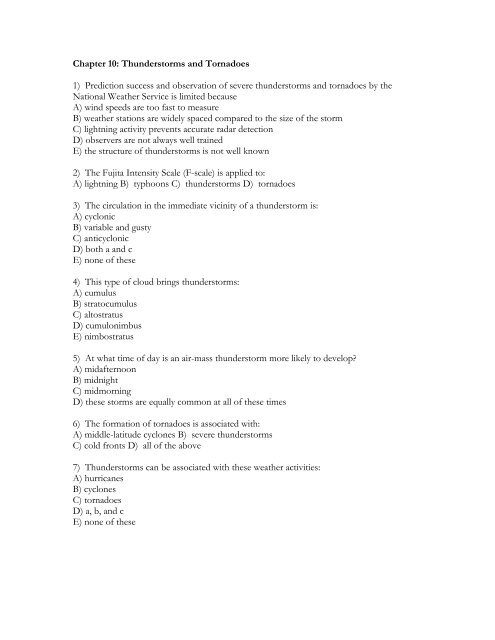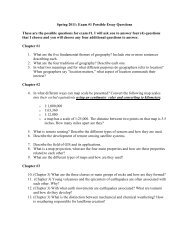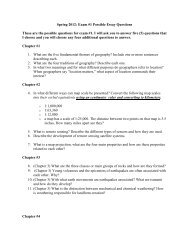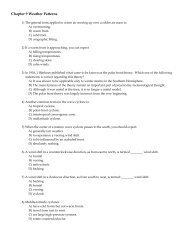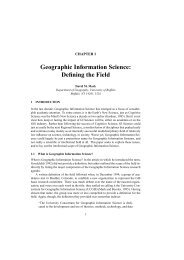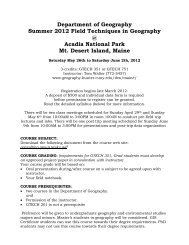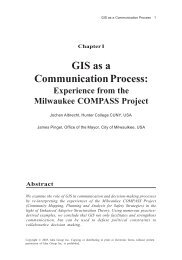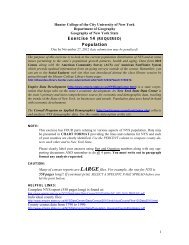Chapter 10: Thunderstorms and Tornadoes 1) Prediction success ...
Chapter 10: Thunderstorms and Tornadoes 1) Prediction success ...
Chapter 10: Thunderstorms and Tornadoes 1) Prediction success ...
Create successful ePaper yourself
Turn your PDF publications into a flip-book with our unique Google optimized e-Paper software.
<strong>Chapter</strong> <strong>10</strong>: <strong>Thunderstorms</strong> <strong>and</strong> <strong>Tornadoes</strong><br />
1) <strong>Prediction</strong> <strong>success</strong> <strong>and</strong> observation of severe thunderstorms <strong>and</strong> tornadoes by the<br />
National Weather Service is limited because<br />
A) wind speeds are too fast to measure<br />
B) weather stations are widely spaced compared to the size of the storm<br />
C) lightning activity prevents accurate radar detection<br />
D) observers are not always well trained<br />
E) the structure of thunderstorms is not well known<br />
2) The Fujita Intensity Scale (F-scale) is applied to:<br />
A) lightning B) typhoons C) thunderstorms D) tornadoes<br />
3) The circulation in the immediate vicinity of a thunderstorm is:<br />
A) cyclonic<br />
B) variable <strong>and</strong> gusty<br />
C) anticyclonic<br />
D) both a <strong>and</strong> c<br />
E) none of these<br />
4) This type of cloud brings thunderstorms:<br />
A) cumulus<br />
B) stratocumulus<br />
C) altostratus<br />
D) cumulonimbus<br />
E) nimbostratus<br />
5) At what time of day is an air-mass thunderstorm more likely to develop?<br />
A) midafternoon<br />
B) midnight<br />
C) midmorning<br />
D) these storms are equally common at all of these times<br />
6) The formation of tornadoes is associated with:<br />
A) middle-latitude cyclones B) severe thunderstorms<br />
C) cold fronts D) all of the above<br />
7) <strong>Thunderstorms</strong> can be associated with these weather activities:<br />
A) hurricanes<br />
B) cyclones<br />
C) tornadoes<br />
D) a, b, <strong>and</strong> c<br />
E) none of these
8) The terms leader, flash, <strong>and</strong> stroke are used when describing:<br />
A) a tornado<br />
B) the passage of a hurricane<br />
C) squall line formation<br />
D) the stages of a thunderstorm<br />
E) none of these<br />
9) Conventional radar measures<br />
A) raindrop motion<br />
B) rainfall intensity<br />
C) cloud droplet numbers<br />
D) raindrop <strong>and</strong> snowflake motion<br />
E) raindrop size<br />
<strong>10</strong>) <strong>Tornadoes</strong> most often move toward what direction?<br />
A) southeast B) west C) northwest D) southwest E) northeast<br />
11) Thunderstorm tops most likely occur<br />
A) in the mesosphere B) in the lower troposphere<br />
C) near the tropopause D) in the middle stratosphere<br />
12) Doppler radars<br />
A) show the motion of precipitation particles<br />
B) have much greater range than conventional radars<br />
C) detect lightning strokes<br />
D) detect condensation nuclei<br />
E) show the motion of air in clear areas<br />
13) <strong>Thunderstorms</strong> <strong>and</strong> large cumulus clouds are characteristic of<br />
A) isothermal lapse rates<br />
B) stable air<br />
C) all polar air masses<br />
D) unstable air<br />
E) all warm fronts<br />
14) Which of the following is likely during the mature stage of a thunderstorm?<br />
A) lightning<br />
B) heavy precipitation<br />
C) gusty winds<br />
D) a, b, <strong>and</strong> c<br />
E) none of these<br />
15) Which of the numbers listed below best represents the percentage of thunderstorms<br />
that produce tornadoes?<br />
A) about <strong>10</strong> percent B) less than 1 percent<br />
C) slightly more than 50 percent D) nearly 25 percent
16) A tornado is a small, very intense example of the<br />
A) geostrophic wind<br />
B) jet stream<br />
C) cyclone<br />
D) anticyclone<br />
E) coriolis effect<br />
17) Which of the following statements is not true of tornadoes?<br />
A) generally move from the southwest toward the northeast<br />
B) usually occur along the warm front of a midlatitude cyclone<br />
C) most common in the Midwest <strong>and</strong> Great Plains<br />
D) associated with cumulonimbus clouds<br />
E) occur most frequently in the spring of the year<br />
18) Why do most tornadoes in the central U.S. occur during the spring months?<br />
A) surface air is most humid<br />
B) air-mass contrasts are greatest<br />
C) divergence of air aloft is greatest<br />
D) solar energy is a maximum<br />
E) upper-air temperatures are warmest<br />
19) Downdrafts <strong>and</strong> updrafts found side by side relate to the ________ in the development<br />
of a thunderstorm.<br />
A) mature stage B) dissipating stage C) cumulus stage<br />
20) The approximate lifetime of an individual thunderstorm cell is about<br />
A) 4 - 8 hours<br />
B) 1 day<br />
C) 12 hours<br />
D) 1 hour or less<br />
E) 15 minutes<br />
21) Which type of lightning is least likely?<br />
A) cloud-to-cloud<br />
B) within the same cloud<br />
C) cloud-to-earth<br />
D) all three are about equally likely<br />
E) b <strong>and</strong> c are about equally the least likely<br />
22) The diameter of a typical tornado funnel cloud would be<br />
A) 4000 meters<br />
B) <strong>10</strong>00 meters<br />
C) 50 meters<br />
D) 200 meters<br />
E) 2500 meters
23) Of the following states, which is struck by the largest number of tornadoes?<br />
A) North Dakota<br />
B) North Carolina<br />
C) New Mexico<br />
D) Ohio<br />
E) Oklahoma<br />
24) Which of the following should have the steepest pressure gradient?<br />
A) hurricane<br />
B) middle-latitude cyclone<br />
C) tornado<br />
D) a, b <strong>and</strong> c should have equally steep pressure gradients<br />
E) both a <strong>and</strong> c have equally steep pressure gradients<br />
25) The gust front occurs<br />
A) during the development of thunderstorm clouds<br />
B) at the leading edge of a thunderstorm downdraft<br />
C) on the lee shore of the Great Lakes<br />
D) near the anvil part of a thunderstorm cloud<br />
26) <strong>Tornadoes</strong> <strong>and</strong> midlatitude cyclones are similar in that:<br />
A) both form in the trade-wind belt<br />
B) both are most common <strong>and</strong> well-developed in the winter season<br />
C) both are areas of low pressure<br />
D) both have conspicuous surface fronts<br />
27) Updrafts dominance relate to the ________ in the development of a thunderstorm.<br />
A) dissipating stage B) cumulus stage C) mature stage<br />
28) Which of these is important to the formation of lightning in a growing cumulus cloud?<br />
A) absorption of solar cosmic rays<br />
B) formation of ice particles<br />
C) formation of mammatus cloud<br />
D) strong vertical currents<br />
E) both b) <strong>and</strong> d)<br />
29) In the development of a thunderstorm, sharp <strong>and</strong> cool gusts beginning at the surface are<br />
characteristic in the ________.<br />
A) mature stage B) cumulus stage C) dissipating stage<br />
30) The greatest proportion of thunderstorms occurs in the<br />
A) subarctic regions<br />
B) middle latitudes<br />
C) tropics<br />
D) polar regions<br />
E) subtropics
31) What does the term mesocyclone refer to in reference to a tornado?<br />
A) a false-alarm tornado warning<br />
B) the rotation motion of the parent thunderstorm<br />
C) a high-altitude tornado<br />
D) a very large tornado<br />
E) none of the above<br />
32) "Heat lightning":<br />
A) is actually a display of the northern lights<br />
B) occurs more than 20 kilometers from the person observing it<br />
C) is also called "ball lightning"<br />
D) is brighter than ordinary lightning<br />
33) Why is strong heating of the ground by the sun associated with thunderstorms?<br />
A) increases the pressure gradient<br />
B) increases the wind speed<br />
C) leads to greater instability<br />
D) reduces the dew point<br />
E) reduces the relative humidity<br />
34) What causes the dissipating stage of a thunderstorm?<br />
A) spreading downdraft cuts off air inflow<br />
B) loss of radiant energy from cloud top<br />
C) release of latent heat within the cloud<br />
D) converging winds aloft<br />
E) converging surface winds<br />
35) Over the last 20 years, which of these has caused the fewest weather related deaths in<br />
the U.S.?<br />
A) hurricanes B) lightning C) floods D) tornadoes<br />
36) An air mass thunderstorm is most intense during the ________ stage.<br />
A) cumulus B) multicell C) mature D) dissipating<br />
37) Why is very humid air near the surface a necessary ingredient for severe thunderstorms?<br />
A) more latent heat is then available as energy for the storm<br />
B) high humidity makes the air more dense<br />
C) high humidity strengthens the cold front<br />
D) high humidity makes the rising air cool more rapidly<br />
E) lapse rates are larger in humid air<br />
38) Why are thunderstorms most likely to occur in the afternoon <strong>and</strong> early evening?<br />
A) upper-level winds are too fast at night <strong>and</strong> in morning<br />
B) water-vapor contents are too low at night<br />
C) it takes all day for them to mature<br />
D) atmosphere is most unstable at that time<br />
E) lower atmosphere is too unstable in the morning
39) If you see lightning <strong>and</strong> then hear the associated thunder <strong>10</strong> seconds later, the lightning<br />
flash was about ________ mile(s) away.<br />
A) three B) one C) five D) four E) two<br />
40) In which of the following places are thunderstorms most common?<br />
A) the occurrence of thunderstorms at all of these places should be about the same<br />
B) west of Hudson Bay (Canada)<br />
C) central Nevada<br />
D) southern Mississippi<br />
E) northern Wisconsin<br />
41) Downdrafts totally dominate the ________ in the development of a thunderstorm.<br />
A) dissipating stage B) cumulus stage C) mature stage<br />
42) <strong>Tornadoes</strong> are most frequent during the:<br />
A) April-June period<br />
B) October-December period<br />
C) January-March period<br />
D) July-August period<br />
E) month of September<br />
TRUE/FALSE. Write 'T' if the statement is true <strong>and</strong> 'F' if the statement is false.<br />
43) Squall lines are easily recognized because of their unique nimbostratus clouds.<br />
44) Lightning only occurs under the central part of a thunderstorm cloud.<br />
45) The airflow pattern aloft is not usually related to severe thunderstorm development.<br />
46) Large hail is associated with cold-front thunderstorms.<br />
47) Weak tornadoes (F0-F1) are responsible for the majority of tornado deaths because they<br />
are far more common than stronger tornadoes (F2 <strong>and</strong> above).<br />
48) The primary force causing the fast winds of a tornado is electrical.<br />
49) On average, tornadoes kill more people every year in the United States than any other<br />
severe weather phenomenon.<br />
50) The anvil top of a thunderstorm often marks the beginning of the stratosphere.<br />
51) Lightning always occurs between a cloud <strong>and</strong> the ground.<br />
52) Thunder generates lightning.<br />
53) A mesocyclone often precedes tornado development.<br />
54) Doppler radar can now provide adequate warning of impending tornadoes at least 95<br />
percent of the time.
55) <strong>Tornadoes</strong> form in association with tall cumulonimbus clouds.<br />
56) Most precipitation from thunderstorms originates through the collision-coalescence<br />
process.<br />
57) A tornado warning is issued by the National Weather Service when conditions are<br />
favorable for tornado development.<br />
58) Lightning results in a net flow of electrons from the ground to the cloud.<br />
59) If a severe thunderstorm produces large hail, it will not produce a tornado.<br />
60) Entrainment refers to the tendency of thunderstorms to form in a line-like pattern or<br />
sequence.<br />
61) A thunderstorm's direction of movement over the ground is determined by the gust<br />
front.<br />
62) The central United States sees more tornadoes than any other region in the world.<br />
63) <strong>Thunderstorms</strong> are not always associated with cyclonic activity.<br />
64) Destruction caused by a tornado is primarily due to the large pressure drop as the funnel<br />
passes over.<br />
65) A tornado watch is issued by the National Weather Service after a tornado has been<br />
sighted in an area.<br />
66) Divergence in the upper-level jet stream hinders the formation of severe thunderstorms.<br />
67) When tornadoes develop it is usually in association with air-mass thunderstorms.<br />
68) Radar detects a thunderstorm by measuring the electrical discharges within the cloud.<br />
69) Temperature inversions (stable layers) in air layers above the ground can contribute to<br />
thunderstorm development.<br />
70) Doppler radar can detect motion directly.<br />
71) About 50 percent of North American tornadoes are classified as violent (F4-F5).


